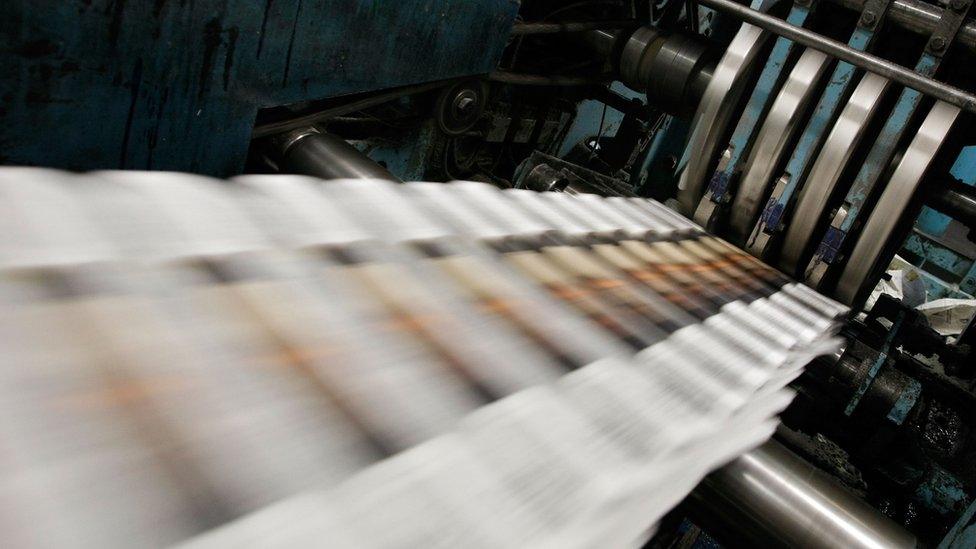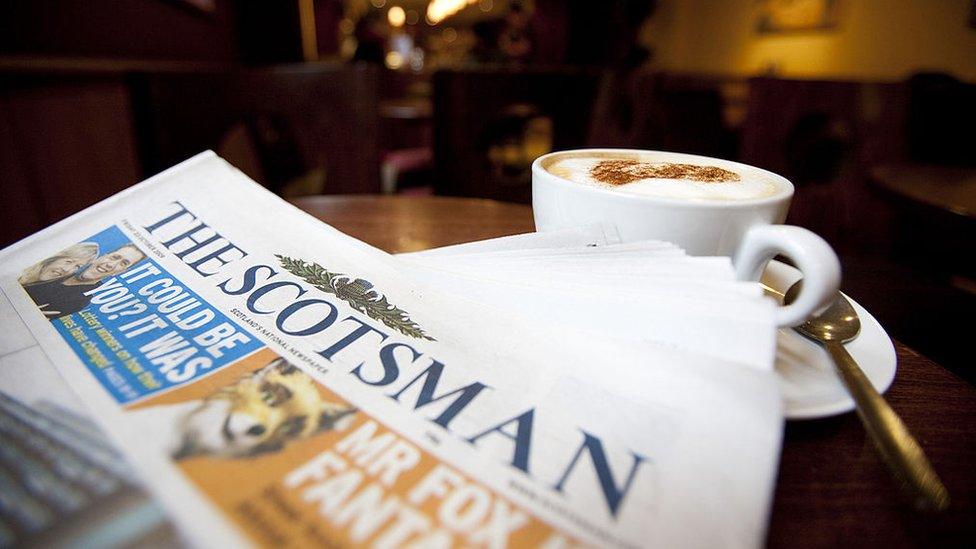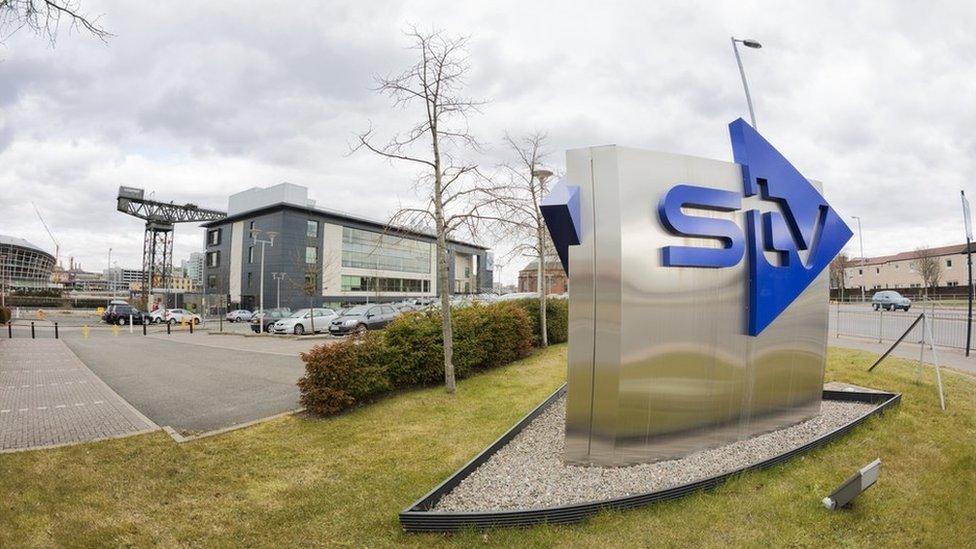Fading newsprint: Scotland's newspapers struggle on
- Published

The decline of commuting, lower advertising spend and soaring costs have added to the difficulties of keeping Scotland's news presses rolling.
Publishers are struggling to switch from print to digital revenue, and cost-cutting brings yet more job losses for journalists.
STV, meanwhile, has a better story to tell about a shift to video-on-demand and programme-making for other broadcasters.
The Courier, Scotsman, Herald and Press & Journal used to be plumbed into the life of Scotland's bigger cities. They were part of the municipal information flow, and the identity of the citizenry.
The Express and Daily Record, and then the Scottish Sun and the Mail, slugged it out for tabloid domination across the country.
The Sunday Post used to sell more than a million copies each week - the biggest market penetration outside the Communist world - until the Sunday Mail overtook it as Scotland's favourite weekend read.
Much of that was within the past half century. Even up to the establishment of the Scottish parliament in 1999, such titles were the place for debate about the country's future and they were an important part of the pressure for devolution. Some argued that was in their commercial interests.
And now? This one-time pillar of Scotland's identity is looking structurally unsound, undermined by technology, trashed on Twitter as "the dead tree" media, and battered by financial pressures.

Reach journalists on strike over pay outside the company's London headquarters last August
The latest such evidence comes from Reach, owner of the Daily Record, Sunday Mail, the Daily Express and Mirror titles as well as more than 100 local titles in the UK.
Its financial results for 2022 expose the pain of soaring costs for energy, ink, plates and particularly newsprint, which is up by 60% in price.
The advertising market has been hit by economic slowdown and like other legacy newspaper businesses, it is struggling to make the transition to a new digital business model.
Reach's newsprint advertising revenue was down 16% and digital ads up only 1%. At £600m, revenue didn't fall that far last year, but profit was down 27% as costs rose by £40m.
For those still buying a paper, the cover price rose and the number of pages fell.
'Steady and predictable'
For shareholders, the price has tumbled more than 80% since it peaked last year.
Reach's chief executive describes circulation trends as "steady and predictable". That means steadily and predictably downwards.
Jim Mullen recently told the Financial Times he's looking at using Artificial Intelligence to write some news stories. With the home market so hard-going, he told shareholders there's a big opportunity for reaching "soccer" fans in the US as well as the Irish-American market.
He may have a point. Those commercial UK news brands that have the more successful or plausible digital strategies are deploying them far beyond Britain, including the Financial Times, the Guardian and the Daily Mail's online stablemate.
If limited to a domestic market, though, it's much harder for everyone to build the scale necessary to monetise journalism viably. There is yet more cost-cutting on the way at Reach: a slowdown in hiring and regrettably, says Mullen, "making some redundancies".

Rupert Murdoch, now aged 91, pictured in 2019 in California
Being listed on the stock exchange, Reach has to put a brave face on it.
Others can hide their pain more easily.
Rupert Murdoch's Times and Sun do not publish the figures they lodge with the Audit Bureau of Circulation (ABC), despite being reckoned to have made a more successful transition to digital than others.
But a further sign of the Times is that the daily operation is being merged with the Sunday Times, and jobs are being lost, in Scotland and elsewhere.
Keeping these teams separate was a promise Rupert Murdoch made in 1981 when he, controversially, took control of The Times.
Other such protections were quickly eroded, but the split of daily and Sunday teams has lasted until now, with permission for merger recently granted by the UK government.
Other Sunday papers long-since merged their journalist teams with dailies, leaving few to focus on weekend news.

DC Thomson publishes magazines and newspapers including the P&J and The Courier
One that stands out as maintaining a distinctive product is the Sunday Post.
Its Dundee-based owner, DC Thomson, saw the need to turn around its decline and the ageing profile of its readership with investment in sharper, less couthy news journalism.
That Scottish publisher, also of the Courier and the Press and Journal, recently said it had to address a £10m gap in its finances. As a consequence, even the P&J's editor departed last week, as morning and evening titles merge operations and focus more on digital.
DC Thomson is axing a raft of magazine titles it recently bought with a Colchester-based company, including leisure, hobby and trade titles.
It is closing five lifestyle and youth magazines based in Dundee. And 300 UK jobs are going, including 100 out of 270 journalists in Scotland told their jobs are "at risk", with 50 of them expected to go.
Poor circulation
The print circulation figures from ABC show why print is increasingly treated as a legacy operation.
There's little hope of winning new converts to print, so the best that can be achieved with it is to hang on to the readers they have had.
Publishers try to use print's remaining cash generation to invest in the technology for harvesting online reader data and learning how to target that at individual readers' potential for spending.
Added to the past 30 years of watching the internet eat its lunch, the newsprint industry has been further undermined by Covid, working from home and the decline of the morning commute. Between 2018 and last year, print sales for The Herald nearly halved to below 13,000.

The Scotsman newspaper was founded in 1817
According to ABC, the Scotsman's average print sale was down to 7,000 in the second half of last year.
Under-investment by previous owners saw the Edinburgh title decline faster than others over recent years. In the half year before Covid struck, its print sales were below 12,000. With sales spread so thinly and limited online income, it is one of the titles likely to be part of any corporate consolidation we might see in the near future.
DC Thomson is a family firm with a long-term view, deep pockets and has appeared to be better tuned in to its readership, in cities and communities north of Scotland's central belt. So the print sales decline has not been as steep as bigger city titles.
In Dundee, The Courier, in the second half of last year, had nearly 19,000 average daily sales. Before Covid, it sold nearly 30,000 copies.
The average daily sale for the Press & Journal in July to December last year was nearly 24,000, down from 38,000 print sales in 2019.
Also on the Scottish newstand, the Daily Record averaged 60,000 daily sales in January, down from 102,000 three years ago. The Daily Mail's sale in Scotland was at 51,400 as the year started, having halved in a decade.
Some will argue their problem is being out of tune with Scottish politics and failing to bang the drum for Scottish independence. One daily paper that does, The National, sells less than 4,000 print copies a day.
Free press
More local papers in Scotland have recently suffered some notable closures, including the Highland News and North Star. In 2021 audited figures, their circulation had fallen well below 1,000 per week, and they have been wrapped into the Inverness Courier and Ross-shire Journal.
While publishers seek to drive advertising into online local brands, those with the healthier print circulation figures are in more remote areas, where owners are willing to invest and the dailies rarely compete. So the bigger sales figures include the Oban Times, with 5,200 per week, and the Dumfries and Galloway Standard on 4,600.
There's high penetration into small markets for the Stornoway Gazette and its Skye-based rival, the West Highland Free Press. The East Lothian Courier, with 6,800 average weekly sales, is more successful than most titles near cities.

One larger legacy media business in Scotland appears to be having a more successful transition.
STV shed its links to the Herald group of newspapers a couple of decades ago. It is still best known for its Channel 3 licences in central and northern Scotland, though that is no longer the licence to print money that it once was, and its future is not guaranteed.
The company's transition has been focussed on the STV Player video-on-demand, its catch-up service.
Along with its financials for 2022, it announced it has passed five million registrations on that app, meaning it is reaching beyond Scotland, and it promised a big new dump of box sets as part of its ever-closer links with ITV.
Advertising in TV is moving rapidly towards spots targeted using data and algorithm. STV has thrown its lot in with ITV's sales team to capture the potential of that.
It has also been pushing hard to become a programme-maker for others, rather than its legacy business model of making programmes for its Channel 3 Scottish audiences.

Some of the media companies battling for your TV viewing
With huge budgets for Netflix, Disney and others trying to grab market share, these can be bumper times for TV 'content creators'.
So the Glasgow firm is aimed at more than doubling its revenue from contracts for such quiz shows, factual and drama programmes this year, with 30 new commissions worth more than £50m.
As maker of Antiques Road Trip, Bridge of Lies and Catchphrase, 11 series are returning. As proven formats, they're highly prized.
STV's revenue was down last year, partly because the Scottish government spent less on public health advertising linked to the pandemic. Pre-tax profit rose 11% to £22m, on revenue of £138m. ITV also warned recently about falling revenue as advertisers weather the economic storm.
There is another large player in news and entertainment which is seeking to find a way through massive changes in the media landscape - not least the question of where the future lies for the licence fee.
But for this week at least, the BBC is looking back at 100 years of broadcasting in Scotland.
Related topics
- Published9 February 2023

